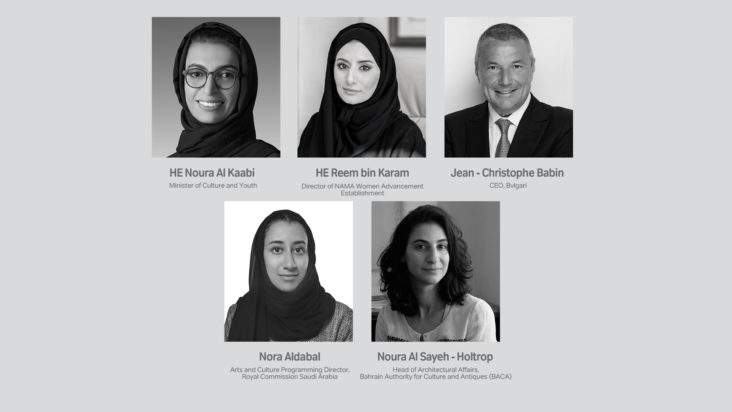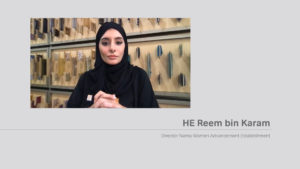Irthi-Bvlgari Panel Emphasises Importance Of Preservation And Documentation Of Cultural Heritage

As part of its mission to preserve and protect Emirati cultural heritage for future generations, Irthi Contemporary Crafts Council has joined hands with Italian jewellery brand, Bvlgari, to explore and analyse practices surrounding the curation and documentation of cultural heritage and to share this knowledge through a series of virtual sessions with experts in the field.
Accordingly, Irthi, an affiliate of the NAMA Women Advancement Establishment, recently organised its second panel in the series titled ‘Cultural Sustainability through Intangible Heritage and Architecture’, in collaboration with Bvlgari.
The discussion was led by HE Noura Al Kaabi, UAE Minister of Culture and Youth; HE Reem BinKaram, Director, NAMA; Jean-Christophe Babin, CEO, Bvlgari; Nora Aldabal, Arts and Culture Programming Director, Royal Commission Saudi Arabia; and Noura Al Sayeh – Holtrop, Head of Architectural Affairs, Bahrain Authority for Culture and Antiques (BACA). Fatema Deemas, Senior Executive Projects Research and Documentation, Irthi, moderated.
Reviving and modernising traditional crafts
Commenting on the UAE’s efforts to preserve and sustain its heritage for future generations, HE Noura Al Kaabi, said: “The UAE has been keenly promoting its unique heritage globally through well-designed initiatives, policies and legislations.Our efforts have led to elements representing Emirati heritage being added to the UNESCO’s Representative List of the Intangible Heritage of Humanity, and we are working closely with local and international partners to ensure that more are recognized in the future.”
Noura Al Kaabi added: “What is most fascinating about these traditions is that they are being preserved through ongoing cultural practices, rather than been confined to a museum setting. In the UAE, entities such as Irthi are playing a pivotal role in fostering a dialogue between contemporary design, traditional craftsmanship and cultural heritage, and thereby transcending the goal of just preserving it.”
HE Reem BinKaram highlighted Sharjah’s strategy of investing in human capital to create the necessary infrastructure for preserving its cultural heritage. She said: “Irthi has taken forward the UAE’s and Sharjah’s vision by creating synergies between contemporary and traditional elements that help retain the distinctive Emirati identity of our crafts while also enhancing their international appeal. Additionally, commercial collaborations with global designers and local artisans are inspiring new ways of incorporating these into our daily lives.”
She continued: “At Irthi, a 360-degree approach governs its efforts in preserving our tangible and intangible heritage. When we first began, our artisans were mostly in the 50-65 age group. Today, we are attracting artisans as young as 24 years, and their craft practice is empowering them socially and economically.”
Enabling knowledge transfer
Describing the lack of focus on manual skills in the western world as the inspiration behind the evolution of the Bvlgary Academy, Jean-Christophe Babin said:“Every year, we train around 120 talents who are passionate about learning the lost skills of crafting exquisite pieces of jewellery. These handcrafted pieces evoke strong emotions and help preserve our cultural heritage.”
“The only way to revive a dying craft is to involve and train the youth,” added BinKaram, elaborating on Irthi’s strategy of enabling knowledge transfer to the young generation. “We collaborate with sister entities and other organisations that support youth to nurture their interest in the crafts. We also created custom design programmes such as Design Labs, to enable them to experiment with different mediums and craft practices.”
Cultural programming
Nora Aldabal offered an insight into the AlUla region, an archaeological treasure at the heart of Saudi Arabia’s heritage programme. Describing AlUla as “an open living museum”, she said:“We are currently developing Madrasat Al Deera, an exciting new project and the first girls’ school in AlUla that was abandoned around 20 years ago. The school is being renovated as a cultural hub and will focus on upscaling artisans’ skills in everything from ceramics and jewellery making to design foundation.”
She added that under the programme, when elderly women infused newly learnt contemporary elements into their crafts, it attracted the attention of both youngsters and hospitality and development projects who are keen on incorporating these into their projects.
Preserving art and architecture
Citing the example of Bahrain’s conservation project, Pearling Paths,Noura Al Sayeh – Holtrop elaborated the role of architecture in resolving the issues of tangible and intangible heritage which, she described as being “two sides of the same coin.”
She said: “Pearling Paths is a tangible heritage that we are safeguarding and conserving and is very much the product of an intangible heritage of the pearling economy. These two aspects are intimately linked.”
Holtrop further explained: “The buildings are the physical testimony of a thousand years of the pearling economy that is largely intangible. To conserve them, we needed to understand its varied intangible elements, specifically the stories behind the buildings, how they were used, the crafts used to build them, and how and by whom they were built. This process was essential to not disrupt the intangible connections that the local community had forged with these buildings and the city.”
Babin emphasised why Bvlgari – a 136-year-old Italian company, felt duty bound to pay tribute to the city of Rome and help preserve its monuments by making them accessible to the public. He said: “We believe that cultural heritage has real value only when it is shared by people and made accessible to all. For instance, Bvlgari is funding the restoration of Largo di Torre Argentinain collaboration with the City Council of Rome and the Ministry of Arts and Culture of Italy.Dating to 4th century BC, this historical site once housed temples and theatres and is the site of Julius Caesar’s assassination. Although the site was excavated about a century ago, it was not maintained or opened to the public.”
The restoration project,which will be open to tourists by the second half of this year, further underlines the significance of conserving historical sites and buildings to safeguard cultural heritage.
Those interested in watching the full panel discussion can visit Irthi’s social media accounts: @Irthicouncil.



